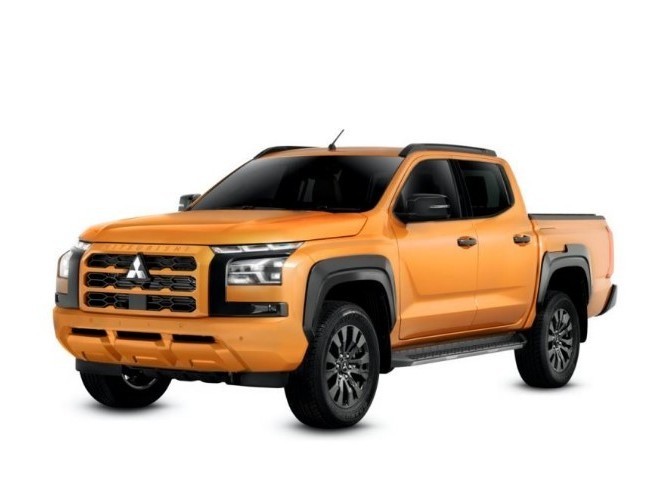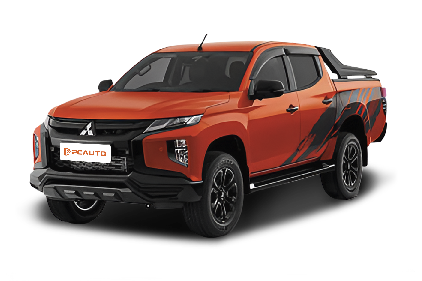Q
How much is a 2020 Mitsubishi Triton worth?
The current used market price for the 2020 Mitsubishi Triton ranges from approximately RM65,000 to RM95,000, with the exact price depending on factors such as vehicle condition, mileage, trim level, and whether it still has the original factory warranty. For example, higher-spec Triton Adventure variants or models equipped with four-wheel drive systems typically command higher prices. This pickup truck is renowned for its durability and off-road capabilities, powered by a 2.4-liter turbocharged diesel engine that delivers 181 horsepower and 430 Nm of torque, paired with either a 6-speed manual or automatic transmission, making it suitable for both daily commuting and outdoor adventures. In the used market, the Triton maintains relatively stable resale value, but it is advisable to have a professional inspection to check the condition of the engine, transmission, and chassis before purchasing, while also reviewing maintenance records to ensure there have been no major accidents. If on a tighter budget, considering 2018-2019 model years could save RM10,000 to RM20,000, though note that some of these may be approaching the end of their warranty period. Additionally, Mitsubishi's extensive after-sales service network and ample parts supply result in lower long-term ownership costs, which is one of the reasons the Triton remains popular in the used market.
Special Disclaimer: This content is published by users and does not represent the views or position of PCauto.
Related Q&A
Q
How much can a 2020 Mitsubishi Triton tow?
The towing capacity of the 2020 Mitsubishi Triton depends on the specific trim and configuration, but generally, it maxes out around 3.1 tonnes. That’s enough for most everyday towing jobs—think small boats, camper trailers, or building materials. Under the hood, this pickup packs a 2.4-liter turbo diesel engine, which dishes out plenty of low-end torque. Paired with either a 6-speed manual or automatic transmission, it keeps power delivery steady even when hauling heavy loads.
A quick heads-up: when you’re actually towing, you’ve got to factor in weight distribution, road conditions, and how well-maintained your truck is. It’s smart to regularly check the brakes and cooling system to stay safe out there. If you’re towing heavy stuff often, consider adding the factory-recommended accessories—things like a trailer stability system or electronic brake controller can really up the safety game. And if you need to tow something even heavier? Best to check the owner’s manual or hit up your dealer to confirm your specific model’s limits. Overloading’s just not worth the risk of damaging your ride.
Q
How much horsepower does a 2020 Triton have?
The 2020 Triton packs 110 horsepower. It's powered by a 2.5-liter (2477cc) diesel engine. This engine cranks out maximum power at 4000 rpm and peak torque at 2000 rpm. It delivers plenty of oomph for daily driving and all sorts of tasks, letting the truck handle different road conditions and payload demands with ease. There might be some performance variations across different trims, but overall, they all offer a reliable and practical driving experience.
Q
What is the fuel consumption of a Mitsubishi Triton 2020?
The fuel economy of the 2020 Mitsubishi Triton varies depending on the specific trim and driving conditions. Official figures show that the version equipped with the 2.4-liter MIVEC turbocharged diesel engine (model 4N15) has a combined fuel consumption of approximately 8.6 liters per 100 kilometers. Manual transmission models might be slightly lower at 8.2 liters per 100 kilometers, while automatic variants tend to be a bit higher due to transmission tuning. In real-world driving, if you frequently carry heavy loads or go off-roading, fuel consumption could rise to 10-12 liters per 100 kilometers. This engine features common rail injection technology and a variable geometry turbocharger, balancing low-end torque with high-rev efficiency. The accompanying Super Select 4WD-II system maintains decent fuel economy even in 4H mode. It's important to note that diesel vehicle fuel consumption is significantly affected by fuel quality; using B7 or higher-grade diesel is recommended to achieve optimal performance. Additionally, regular maintenance of the fuel filter and injectors is crucial for keeping fuel consumption in check. Rivals in the same pickup segment like the Toyota Hilux and Ford Ranger have similar fuel economy figures, but the Triton's lightweight chassis design gives it a slight edge when unladen. Adding a bed cover or reducing highway cruising RPM can further optimize fuel efficiency.
Q
How much does a 2020 Mitsubishi cost?
The specific price of a 2020 Mitsubishi model depends on the vehicle type and configuration. For example, a used Mitsubishi Triton pickup truck costs around 80,000 to 120,000 Malaysian Ringgit, while the ASX compact SUV ranges from 70,000 to 100,000 Malaysian Ringgit. Actual prices are affected by condition, mileage, and additional features. Mitsubishi vehicles are known for durability and practicality. The Triton, for instance, suits users needing strong power and off-road capability, while the ASX is better for city driving with good fuel efficiency. When buying a used car, it's advisable to check maintenance records and vehicle history to ensure no major accidents. Additionally, Mitsubishi has an extensive after-sales network, sufficient parts supply, and relatively reasonable maintenance costs—all factors worth considering.
Q
How much is a Mitsubishi Triton 2020?
The 2020 Mitsubishi Triton Quest is priced at RM 81,390. This model runs on diesel fuel and is powered by a 2.5-liter engine with a maximum output of 110 horsepower. It comes with a 5-year or 100,000-kilometer warranty. The spacious interior and large 75-liter fuel tank make it suitable for various needs. Its 4x4 drive system and manual transmission provide decent control over different terrains. The vehicle is also equipped with standard safety features like ABS and multiple airbags to ensure driving safety.
Q
What is the fuel economy of the 2021 Triton?
The fuel efficiency of the 2021 Mitsubishi Triton in the Malaysian market varies by model and drivetrain. According to official figures, the 2.4-liter turbo diesel engine (4N15 model) delivers a combined fuel consumption of approximately 7.6 liters per 100 km for the 2WD manual variant, while the 4WD automatic version comes in around 8.2 liters per 100 km. This engine features Mitsubishi's innovative variable geometry turbo technology, balancing low-end torque with high fuel efficiency. For Malaysian users who frequently need to carry loads or drive long distances, the diesel engine's low-rev, high-torque characteristics are particularly well-suited for local mountainous terrain and hot climatic conditions. It's worth noting that actual fuel consumption can be affected by driving habits, road conditions, and payload. Owners are advised to perform regular vehicle maintenance and maintain proper tire pressure to achieve optimal fuel efficiency. Among pickups in its class, the Triton's fuel economy ranks above average. Its Super Select 4WD-II system not only provides off-road capability but also optimizes power distribution for on-road driving, which is especially useful during the rainy season on Malaysia's east coast or for plantation road conditions. To further reduce fuel consumption, consider using the factory-fitted ECO driving mode, which enhances efficiency by adjusting throttle response and shift logic.
Q
How much power does the 2021 Mitsubishi Triton have?
The 2021 Mitsubishi Triton offers varying powertrain configurations across its trim levels in the Malaysian market. The range-topping Triton Athlete is equipped with a 2.4-liter MIVEC turbocharged diesel engine, churning out 181 horsepower and a peak torque of 430 Nm, paired with a 6-speed automatic transmission that balances off-road capability with daily driving needs. Entry-level models, on the other hand, use the same engine but in a slightly detuned state, delivering 150 horsepower and 400 Nm of torque.
This pickup truck is renowned for its robust chassis and Super Select 4WD system (available on certain variants), making it well-suited for Malaysia's diverse terrains. It also boasts a 5,250kg towing capacity, catering to both commercial and recreational demands. Notably, the diesel engine's low-end torque trait excels when hauling heavy loads or climbing slopes, while Mitsubishi's Dynamic Shield design language gives the exterior a modern touch. For users prioritizing fuel efficiency, the Triton's AdBlue diesel exhaust treatment technology effectively reduces emissions, complying with Malaysia's increasingly stringent environmental standards. These features keep it competitive in the local pickup truck market.
Q
What are the most common problems with the 2021 Mitsubishi Outlander Sport?
Common issues with the 2021 Mitsubishi Outlander Sport in the Malaysian market include transmission jerkiness, especially noticeable during low-speed gear changes. This is likely due to the CVT transmission tuning prioritizing fuel efficiency, so it's advisable to regularly check the transmission fluid condition to ensure smooth operation. Some owners have reported that the suspension is on the stiff side, which compromises comfort a bit when going over rough roads in Malaysia, but this actually enhances the vehicle's stability in corners. Interior sound insulation is average; wind and tire noise become quite noticeable at highway speeds, and upgrading the insulation materials could help improve this. Additionally, the infotainment system occasionally exhibits slow response; keeping the system software updated usually resolves such issues. It's worth noting that the car's 1.5L MIVEC engine performs reliably in Malaysia's hot climate, with a cooling system design that handles high temperatures well, and maintenance costs are relatively reasonable, making it well-suited for local consumers. Despite these minor drawbacks, the Outlander Sport remains a popular choice in Malaysia's urban SUV segment thanks to its flexible space layout and higher ground clearance compared to its peers. Prospective buyers are advised to pay close attention to the above aspects during a test drive to ensure it meets their personal needs.
Q
How many miles per gallon does a 2021 Mitsubishi get?
Mitsubishi's fuel efficiency in 2021 varies by model and powertrain. Take the Outlander, for example – the 2.4L four-cylinder front-wheel-drive version gets around 25 mpg combined (about 10.6 km/L). The plug-in hybrid (PHEV) model, on the other hand, delivers better efficiency in all-electric mode, though actual numbers depend on driving conditions and battery state. For Malaysian buyers, fuel economy is also affected by local road conditions, driving habits, and fuel quality. It’s best to check Mitsubishi Malaysia’s official localized data or real owner reviews for the most accurate info. With hybrids and EVs gaining traction globally, if you’re thinking about long-term running costs, keep an eye on Mitsubishi’s new energy tech – stuff like the PHEV system’s regenerative braking and all-electric range, which can really cut down on fuel use for city commutes. When picking a model, make sure to factor in your daily driving distance and how easy it is to access charging stations.
Q
What kind of engine is in the 2021 Triton GSR?
The 2021 Mitsubishi Triton GSR is powered by a 2.4-liter MIVEC turbocharged diesel engine, which features Mitsubishi's advanced common-rail direct injection technology and a variable geometry turbocharger. It cranks out 181 horsepower and a peak torque of 430 Nm, mated to a 6-speed automatic transmission, delivering strong performance and impressive fuel efficiency. It's perfectly suited for Malaysia's diverse road conditions, handling both city driving and off-road adventures with ease. This engine also meets Euro 5 emission standards, showcasing Mitsubishi's commitment to eco-friendly technology. For Malaysian consumers, the Triton GSR's engine isn't just powerful; it's also highly durable and relatively low-maintenance, making it a standout in Mitsubishi's pickup truck lineup. What's more, the turbo diesel engine provides high torque at low revs, making the vehicle particularly capable when hauling loads or towing, ideal for users who need frequent transportation or enjoy outdoor activities.
Latest Q&A
Q
How much is a Toyota Harrier 2023?
The 2023 Toyota Harrier is priced locally between approximately RM200,000 and RM250,000, varying by trim level and configuration. Exact prices may fluctuate depending on dealer promotions or optional accessories. The vehicle offers two powertrain options: a 2.0-liter naturally aspirated engine and a 2.5-liter hybrid system. The hybrid variant stands out for its fuel efficiency, making it ideal for eco-conscious buyers. The Harrier has gained popularity for its sleek exterior design, spacious interior, and generous tech features – like the standard Toyota Safety Sense suite, which includes pre-collision safety, lane departure alert, and other functions. Notably, it shares a platform with the Lexus NX, resulting in a solid driving experience. Recent fluctuations in the Japanese Yen exchange rate could impact import vehicle pricing, so it’s advisable to compare quotes from multiple authorized dealers before purchasing. Keep an eye out for promotional offers or low-interest financing deals too. Besides the Harrier, competitors in the same price range include the Honda CR-V and Mazda CX-5, each with distinct strengths in space, power, or handling.
Q
How much can a 2020 Mitsubishi Triton tow?
The towing capacity of the 2020 Mitsubishi Triton depends on the specific trim and configuration, but generally, it maxes out around 3.1 tonnes. That’s enough for most everyday towing jobs—think small boats, camper trailers, or building materials. Under the hood, this pickup packs a 2.4-liter turbo diesel engine, which dishes out plenty of low-end torque. Paired with either a 6-speed manual or automatic transmission, it keeps power delivery steady even when hauling heavy loads.
A quick heads-up: when you’re actually towing, you’ve got to factor in weight distribution, road conditions, and how well-maintained your truck is. It’s smart to regularly check the brakes and cooling system to stay safe out there. If you’re towing heavy stuff often, consider adding the factory-recommended accessories—things like a trailer stability system or electronic brake controller can really up the safety game. And if you need to tow something even heavier? Best to check the owner’s manual or hit up your dealer to confirm your specific model’s limits. Overloading’s just not worth the risk of damaging your ride.
Q
How much horsepower does a 2020 Triton have?
The 2020 Triton packs 110 horsepower. It's powered by a 2.5-liter (2477cc) diesel engine. This engine cranks out maximum power at 4000 rpm and peak torque at 2000 rpm. It delivers plenty of oomph for daily driving and all sorts of tasks, letting the truck handle different road conditions and payload demands with ease. There might be some performance variations across different trims, but overall, they all offer a reliable and practical driving experience.
Q
What is the fuel consumption of a Mitsubishi Triton 2020?
The fuel economy of the 2020 Mitsubishi Triton varies depending on the specific trim and driving conditions. Official figures show that the version equipped with the 2.4-liter MIVEC turbocharged diesel engine (model 4N15) has a combined fuel consumption of approximately 8.6 liters per 100 kilometers. Manual transmission models might be slightly lower at 8.2 liters per 100 kilometers, while automatic variants tend to be a bit higher due to transmission tuning. In real-world driving, if you frequently carry heavy loads or go off-roading, fuel consumption could rise to 10-12 liters per 100 kilometers. This engine features common rail injection technology and a variable geometry turbocharger, balancing low-end torque with high-rev efficiency. The accompanying Super Select 4WD-II system maintains decent fuel economy even in 4H mode. It's important to note that diesel vehicle fuel consumption is significantly affected by fuel quality; using B7 or higher-grade diesel is recommended to achieve optimal performance. Additionally, regular maintenance of the fuel filter and injectors is crucial for keeping fuel consumption in check. Rivals in the same pickup segment like the Toyota Hilux and Ford Ranger have similar fuel economy figures, but the Triton's lightweight chassis design gives it a slight edge when unladen. Adding a bed cover or reducing highway cruising RPM can further optimize fuel efficiency.
Q
How much does a 2020 Mitsubishi cost?
The specific price of a 2020 Mitsubishi model depends on the vehicle type and configuration. For example, a used Mitsubishi Triton pickup truck costs around 80,000 to 120,000 Malaysian Ringgit, while the ASX compact SUV ranges from 70,000 to 100,000 Malaysian Ringgit. Actual prices are affected by condition, mileage, and additional features. Mitsubishi vehicles are known for durability and practicality. The Triton, for instance, suits users needing strong power and off-road capability, while the ASX is better for city driving with good fuel efficiency. When buying a used car, it's advisable to check maintenance records and vehicle history to ensure no major accidents. Additionally, Mitsubishi has an extensive after-sales network, sufficient parts supply, and relatively reasonable maintenance costs—all factors worth considering.
View MoreRelated News

Why is the Mitsubishi Triton So Popular? Key: Sturdy Chassis and Excellent Four-Wheel Drive
WilliamApr 21, 2025

Brand new Mitsubishi Triton releasing on 16th October, limited time offer price RM102k-RM170k
JohnOct 15, 2024

Don't panic at the diesel price increase! These fuel-efficient car models are your best choices!
JamesSep 19, 2024

Mitsubishi Lancer Evolution might be resurrected, so what will the new Evo look like?
WilliamNov 14, 2025

Choose Honda HR-V or Mitsubishi XPANDER for a family car?
WilliamNov 12, 2025
View More













Pros
Cons